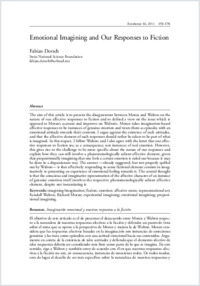Emotional Imagining and Our Responses to Fiction
BHAP-PH
- Dorsch, Fabian Université de Fribourg
-
2011
Published in:
- Enrahonar. - 2011, vol. 46, p. 153-176
imagining/imagination
fiction
emotion
affective states
representational art
Kendall Walton
Richard Moran
experiential imagining
emotional imagining
propositional imagining
English
The aim of this article is to present the disagreement between Moran and Walton on the nature of our affective responses to fiction and to defend a view on the issue which is opposed to Moran’s account and improves on Walton’s. Moran takes imagination-based affective responses to be instances of genuine emotion and treats them as episodes with an emotional attitude towards their contents. I argue against the existence of such attitudes, and that the affective element of such responses should rather be taken to be part of what is imagined. In this respect, I follow Walton; and I also agree with the latter that our affective responses to fiction are, as a consequence, not instances of real emotion. However, this gives rise to the challenge to be more specific about the nature of our responses and explain how they can still involve a phenomenologically salient affective element, given that propositionally imagining that one feels a certain emotion is ruled out because it may be done in a dispassionate way. The answer —already suggested, but not properly spelled out by Walton— is that affectively responding to some fictional element consists in imaginatively re-presenting an experience of emotional feeling towards it. The central thought is that the conscious and imaginative representation of the affective character of an instance of genuine emotion itself involves the respective phenomenologically salient affective element, despite not instantiating it.
- Faculty
- Faculté des lettres et des sciences humaines
- Department
- Département de Philosophie
- Language
-
- English
- Classification
- Philosophy, psychology
- License
-
License undefined
- Identifiers
-
- RERO DOC 232891
- DOI 10.5565/rev/enrahonar/v46n0.197
- Persistent URL
- https://folia.unifr.ch/unifr/documents/303908
Statistics
Document views: 167
File downloads:
- Texte intégral: 183
